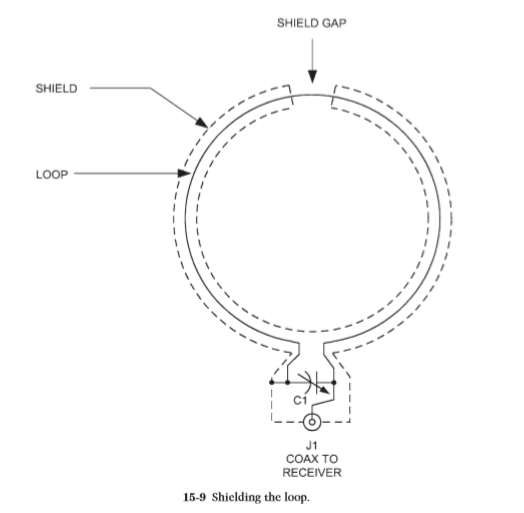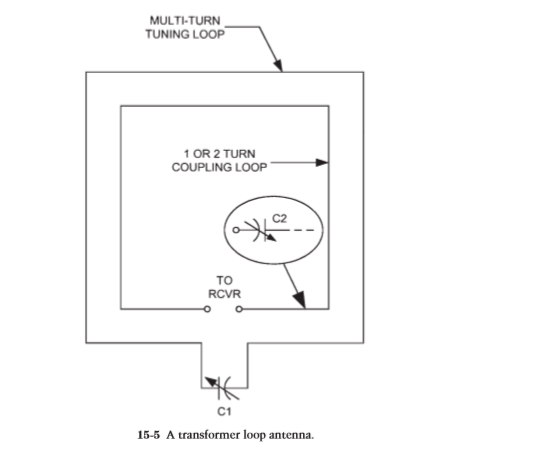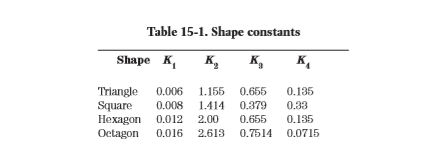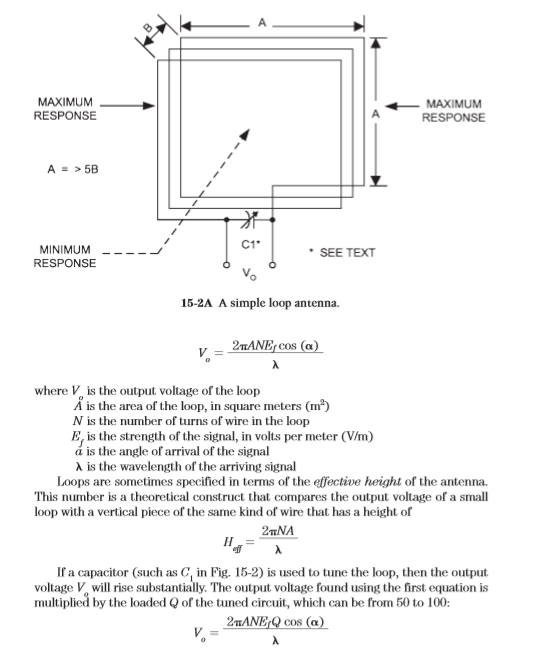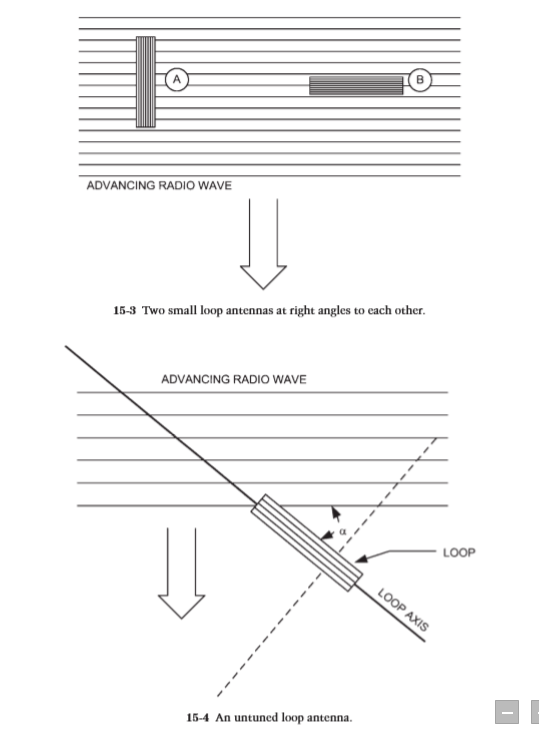Most readers will use a loop for DXing rather than hidden transmitter hunting, navigation, or other RDF purposes. For the DXer, there are actually two uses for the
loop. One is when you are a renter or live in a community that has routine covenants against outdoor antennas. In this situation, the loop will serve as an active antenna for receiving AM BCB and other low-frequency signals without the neighbors or landlord becoming PFJs (“purple-faced jerks”). The other use is illustrated by the case of a friend of mine. He regularly tunes in clear channel WSM (650 kHz, Nashville) in the wee hours between Saturday evening (“Grand Ole Opry” time) and dawn. However, this “clear” channel of WSM is not really so clear, especially without a narrow filter in the receiver. He uses a loop antenna to null out a nearby 630-kHz signal that made listening a bit dicey and can now tape his 1940s–1950s vintage country music. It is not necessary to place the desired station directly in the main lobes off the ends of the antenna but rather to place the nulls (broadside) in the direction of the offending station that you want to eliminate. So what happens if the offending station and the desired station are in a direct line with each other and your receiving location is in the middle between them? Both nulls and lobes on a loop antenna are bidirectional, so a null on the offending station also will null the desired station in the opposite direction. One method is to use a sense antenna to spoil the pattern of the loop to a cardioid shape. Another method is to use a spoiler loop to null the undesired signal. The spoiler loop is a large box loop placed 1 to 3 ft (found experimentally) behind the reception loop in the direction of the offending signal. This method was first described by Levintow and is detailed in Fig. 15-10. The small loopstick may be the antenna inside the receiver, whereas the large loop is a box loop such as the sports fan’s loop. The large box loop is placed about 33 to 100 cm behind the loopstick and in the direction of the offending station. The angle with respect to the line of centers should be 60° to 90°, which also was found experimentally. It is also possible to use two air core loops to produce an asymmetrical receiving pattern.
Complete free tutorial antennas design , diy antenna , booster antenna, filter antenna , software antenna , free practical antenna book download !
Shielded Loop Antennas
The loop antennas discussed thus far in this chapter have all been unshielded types. Unshielded loops work well under most circumstances, but in some cases their pattern is distorted by interaction with the ground and nearby structures (trees, buildings, etc.). In my own tests, trips to a nearby field proved necessary to measure the depth of the null because of interaction with the aluminum siding on my house. Figure 15-8 shows two situations. In Fig. 15-8A we see the pattern of the normal “free space” loop, i.e., a perfect figure-8 pattern. When the loop interacts with the nearby environment, however, the pattern distorts. In Fig. 15-8B we see some filling of the notch for a moderately distorted pattern. Some interactions are so severe that the pattern is distorted beyond all recognition.
The solution to the problem is to reduce interaction by shielding the loop, as in Fig. 15-9. Loop antennas operate on the magnetic component of the electromagnetic wave, so the loop can be shielded against voltage signals and electrostatic interactions. In order to prevent harming the ability to pick up the magnetic field, a gap is left in the shield at one point. There are several ways to shield a loop. You can, for example, wrap the loop in adhesive-backed copper-foil tape. Alternatively, you can wrap the loop in aluminum foil and hold it together with tape. Another method is to insert the loop inside a copper or aluminum tubing frame. Or—the list seems endless.
Tuning Schemes for Loop Antennas
Loop performance is greatly enhanced by tuning the inductance of the loop to the desired frequency. The bandwidth of the loop is reduced, which reduces front-end overload. Tuning also increases the signal level available to the receiver by a factor of 20 to 100 times. Although tuning can be a bother if the loop is installed remotely from the receiver, the benefits are well worth it in most cases. There are several different schemes available for tuning, and these are detailed in Fig. 15-6. The parallel tuning scheme, which is by far the most popular, is shown in Fig. 15-6A. In this type of circuit, the capacitor (C1) is connected in parallel with the inductor, which in this case is the loop. Parallel resonant circuits have a very high impedance to signals on their resonant frequency and a very low impedance to other frequencies.
As a result, the voltage level of resonant signals is very much larger than the voltage level of off-frequency signals. The series resonant scheme is shown in Fig. 15-6B. In this circuit, the loop is connected in series with the capacitor. A property of series resonant circuits is that they offer a high impedance to all frequencies except the resonant frequency (exactly the opposite of the case of parallel resonant circuits).
As a result, current from the signal will pass through the series resonant circuit at the resonant frequency, but off-frequency signals are blocked by the high impedance. There is a wide margin for error in the inductance of loop antennas, and even the precise-looking equations to determine the required values of capacitance and inductance for proper tuning are actually only estimations. The exact geometry of the loop “as built” determines the actual inductance in each particular case. As a result, it is often the case that the tuning provided by the capacitor is not as exact as desired, so some form of compensation is needed. In some cases, the capacitance required for resonance is not easily available in a standard variable capacitor, and some means must be provided for changing the capacitance.
Figure 15-6C shows how this is done. The main tuning capacitor can be connected in either series or parallel with other capacitors to change the value. If the capacitors are connected in parallel, then the total capacitance is increased (all capacitances are added together). If the extra capacitor is connected in series, however, then the total capacitance is reduced. The extra capacitors can be switched in and out of a circuit to change frequency bands. Tuning of a remote loop can be a bother if it is done by hand, so some means must be found to do it from the receiver location (unless you enjoy climbing into the attic or onto the roof). Traditional means of tuning called for using a low-rpm dc motor, or stepper motor, to turn the tuning capacitor. A very popular combination was the little 1- to 12-rpm motors used to drive rotating displays in retail store show
windows. But this approach is not really needed today. We can use varactor voltagevariable capacitance diodes to tune the circuit. A varactor works because the junction capacitance of the diode is a function of the applied reverse-bias voltage. A high voltage (such as 30 V) drops the capacitance, whereas a low voltage increases it. Varactors are available with maximum capacitances of 22, 33, 60, 100, and 400 pF. The latter are of most interest to us because they have the same range as the tuning capacitors normally used with loops. Figure 15-7 shows how a remote tuning scheme can work with loop antennas. The tuning capacitor is a combination of a varactor diode and two optional capacitors: a fixed capacitor (C1) and a trimmer (C2). The dc tuning voltage (V t) is provided from the receiver end from a fixed dc power supply (V
). A potentiometer (R1) is used to set the voltage to the varactor, hence also to tune the loop. A dc blocking capacitor (C3) keeps the dc tuning voltage from being shorted out by the receiver input circuitry.
As a result, the voltage level of resonant signals is very much larger than the voltage level of off-frequency signals. The series resonant scheme is shown in Fig. 15-6B. In this circuit, the loop is connected in series with the capacitor. A property of series resonant circuits is that they offer a high impedance to all frequencies except the resonant frequency (exactly the opposite of the case of parallel resonant circuits).
As a result, current from the signal will pass through the series resonant circuit at the resonant frequency, but off-frequency signals are blocked by the high impedance. There is a wide margin for error in the inductance of loop antennas, and even the precise-looking equations to determine the required values of capacitance and inductance for proper tuning are actually only estimations. The exact geometry of the loop “as built” determines the actual inductance in each particular case. As a result, it is often the case that the tuning provided by the capacitor is not as exact as desired, so some form of compensation is needed. In some cases, the capacitance required for resonance is not easily available in a standard variable capacitor, and some means must be provided for changing the capacitance.
Figure 15-6C shows how this is done. The main tuning capacitor can be connected in either series or parallel with other capacitors to change the value. If the capacitors are connected in parallel, then the total capacitance is increased (all capacitances are added together). If the extra capacitor is connected in series, however, then the total capacitance is reduced. The extra capacitors can be switched in and out of a circuit to change frequency bands. Tuning of a remote loop can be a bother if it is done by hand, so some means must be found to do it from the receiver location (unless you enjoy climbing into the attic or onto the roof). Traditional means of tuning called for using a low-rpm dc motor, or stepper motor, to turn the tuning capacitor. A very popular combination was the little 1- to 12-rpm motors used to drive rotating displays in retail store show
windows. But this approach is not really needed today. We can use varactor voltagevariable capacitance diodes to tune the circuit. A varactor works because the junction capacitance of the diode is a function of the applied reverse-bias voltage. A high voltage (such as 30 V) drops the capacitance, whereas a low voltage increases it. Varactors are available with maximum capacitances of 22, 33, 60, 100, and 400 pF. The latter are of most interest to us because they have the same range as the tuning capacitors normally used with loops. Figure 15-7 shows how a remote tuning scheme can work with loop antennas. The tuning capacitor is a combination of a varactor diode and two optional capacitors: a fixed capacitor (C1) and a trimmer (C2). The dc tuning voltage (V t) is provided from the receiver end from a fixed dc power supply (V
). A potentiometer (R1) is used to set the voltage to the varactor, hence also to tune the loop. A dc blocking capacitor (C3) keeps the dc tuning voltage from being shorted out by the receiver input circuitry.
Transformer Loop Antenna
It is common practice to make a small loop antenna with two loops rather than just one. Figure 15-5 shows such a transformer loop antenna. The main loop is built exactly as discussed above: several turns of wire on a large frame, with a tuning capacitor to resonate it to the frequency of choice. The other loop is a one- or two-turn coupling loop.This loop is installed in very close proximity to the main loop, usually (but not necessarily) on the inside edge not more than a couple of centimeters away. The purpose of this loop is to couple signal induced from the main loop to the receiver at a more reasonable impedance match. The coupling loop is usually untuned, but in some designs a tuning capacitor (C2) is placed in series with the coupling loop. Because there are many fewer turns on the coupling loop than on the main loop, its inductance is considerably smaller. As a result, the capacitance to resonate is usually much larger. In several loop antennas constructed for purposes of researching this chapter,
I found that a 15-turn main loop resonated in the AM BCB with a standard 365-pF capacitor, but the two-turn coupling loop required three sections of a ganged 3 365-pF capacitor connected in parallel to resonate at the same frequencies. In several experiments, I used computer ribbon cable to make the loop turns. This type of cable consists of anywhere from 8 to 64 parallel insulated conductors arranged in a flat ribbon shape. Properly interconnected, the conductors of the ribbon cable form a continuous loop. It is no problem to take the outermost one or two conductors on one side of the wire array and use them for a coupling loop.
I found that a 15-turn main loop resonated in the AM BCB with a standard 365-pF capacitor, but the two-turn coupling loop required three sections of a ganged 3 365-pF capacitor connected in parallel to resonate at the same frequencies. In several experiments, I used computer ribbon cable to make the loop turns. This type of cable consists of anywhere from 8 to 64 parallel insulated conductors arranged in a flat ribbon shape. Properly interconnected, the conductors of the ribbon cable form a continuous loop. It is no problem to take the outermost one or two conductors on one side of the wire array and use them for a coupling loop.
Air core frame loops (“box” loops)
A wire loop antenna is made by winding a large coil of wire, consisting of one or more turns, on some sort of frame. The shape of the loop can be circular, square, triangular, hexagonal, or octagonal. For practical reasons, the square loop seems to be most popular. With one exception, the loops considered in this section will be square, so you can easily duplicate them. The basic form of the simplest loop is shown in Fig. 15-2. This loop is square, with sides the same length A all around. The width of the loop (B) is the distance from the first turn to the last turn in the loop, or the diameter of the wire if only one turn is used. The turns of the loop in Fig. 15-2 are depth wound, meaning that each turn of the loop is spaced in a slightly different parallel plane. The turns are spaced evenly across distance B. Alternatively, the loop can be wound such that the turns are in the same plane (this is called planar winding). In either case, the sides of the loop (A) should be not less than five times the width (B). There seems to be little difference between depth- and planar-wound loops. The far-field patterns of the different shape loops are nearly the same if the respective cross-sectional areas ( r2 for circular loops and A2 for square loops) are less than 2/100. The reason why a small loop has a null when its broadest aspect is facing the signal is simple, even though it seems counterintuitive at first blush. Take a look at Fig. 15-3. Here, we have two identical small loop antennas at right angles to each other. Antenna A is in line with the advancing radio wave, whereas antenna B is broadside to the wave. Each line in the wave represents a line where the signal strength is the same, i.e., an “isopotential line.” When the loop is in line with the signal (antenna A), there is a difference of potential from one end of the loop to the other, so current can be induced in the wires. When the loop is turned broadside, however, all points on the loop are on the same potential line, so there is no difference of potential between segments of the conductor. Thus little signal is picked up (and the antenna therefore sees a null). The actual voltage across the output terminals of an untuned loop is a function of the angle of arrival of the signal (Fig. 15-4), as well as the strength of the signal and the design of the loop. The voltage Vo is given by
Even though the output signal voltage of tuned loops is higher than that of untuned loops, it is nonetheless low compared with other forms of antenna. As a result, a loop preamplifier usually is needed for best performance.
Even though the output signal voltage of tuned loops is higher than that of untuned loops, it is nonetheless low compared with other forms of antenna. As a result, a loop preamplifier usually is needed for best performance.
Subscribe to:
Comments (Atom)
